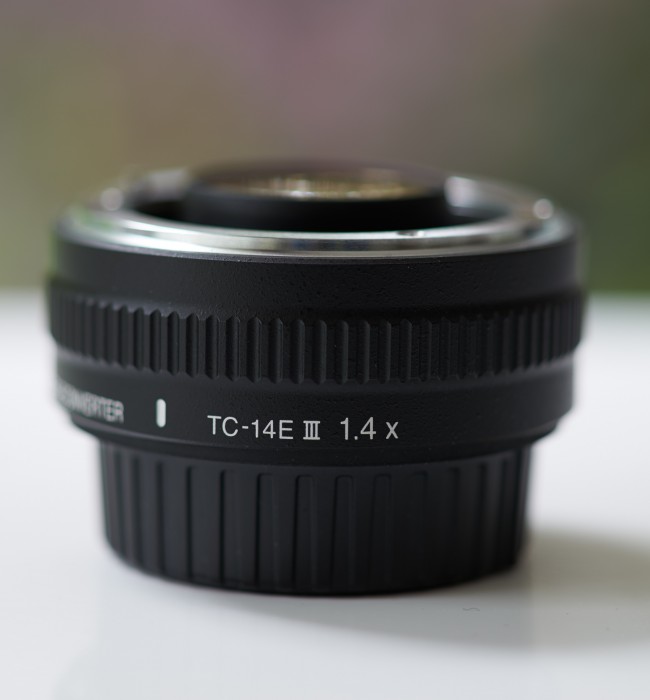
This is a review of the mark III version of the Nikon TC-14 teleconverter, which was announced in May. Teleconverters had the reputation of reducing image quality by a noticeable amount. But already the predecessor TC-14E II model has been praised for its performance and very little performance degradation when combined with the professional telephoto lenses. I ordered the updated converter on the day it was announced and got it delivered from Calumet Munich last week.
Weighing only 190 grams, the TC-14E III works with Nikon telephoto lenses to effectively multiply the focal length by 1.4 times, with a resultant 1.3 stop* decrease in maximum aperture. My objective was to test the converter specifically with the Nikon 85 f2.8 PC-E, the Nikon 70-200 f/2.8 VR II, and the Nikon 200-400 f/4 VR lenses. It is one thing to photograph Siemens stars or look at MTF charts, but real-world test criteria depend on the primary use of the lens on which the converter is mounted.
*It is claimed to be one f-stop, but remember the infamous difference between t-stops and f-stops. From my experience in the field, you will loose a tad more than one stop.
The 85 PC-E is the sharpest lens in my bag, so the question was if the teleconverter would be able to extend its focal lengths to 119 mm with the tilt and shift options to boot, while keeping the high edge-to-edge resolution. Now this question is quickly out of the way: the converter will not mount. I should have read the compatibility list beforehand. This list, by the way, excludes all lenses below 105 mm focal lengths, including the fast primes, and all the older AF-S lenses with an aperture ring. In particular for the PC-E lenses there would be no interference between the lens’ rear and the converter’s front elements. An extra tab on the front bayonet of the converter prevents you from mounting these lenses. If it wasn’t such an expensive experiment, I would be tempted to take out the grinder.
For my upcoming trip to the Himalayas, the 70-200 f/2.8 VR II and TC-14E III combo will serve for detail shots of glaciated mountain faces, so the ultimate edge-to-edge performance at 280 mm and aperture f/5.6 is a main criterium here. This combo also allows the somewhat academic comparison of the image quality when setting the zoom lens to 75, 107 and 142 mm using the converter, and to the equivalent 105, 150 and 200 mm without the converter.
The performance at 280 and f/5.6 will have to compete with the 200-400 f/4 VR zoom lens at the same focal length and aperture. Focusing speed and center performance will be important when shooting sports and wildlife, which is the main application for the 200-400 f/4 VR zoom lens, becoming a 280-560 f/5.6 when paired with the converter.
It does not make much sense to shoot landscapes with the converter in place, when by zooming in you can arrive at the same focal length. But when wildlife approaches, there will be simply no time to dismount a converter. Moreover, the 200-400 f/4 VR is not known to yield its best results at infinity. Except perhaps for some staged mountain ridges, or the moon, I cannot envisage many subjects to be shot with a 400+ mm lens at infinity. In this range, the largest detriments to sharpness are temperature variations in the atmosphere creating shimmers. In extreme cases these appear as mirages, but when using super-teles these shimmers even show up in normal conditions. You need really clear air to make use of such focal lengths at infinity.
The optical design of the converter has changed quite significantly between the new and the older versions. It now features 7 elements in 4 groups, versus the 5 elements in 5 groups design of the TC-14E II, so there are more optical elements to maintain high image quality and reduce lens aberrations. Fluorine coating was added to protect the front and rear surfaces and to reduce coma and flare. This teleconverter has the full set of electronic contacts to support the AF-S lenses; the correct, extended focal lengths is written into the EXIF data. The electronic contacts are retracted from the front element, which protrudes from the lens barrel and thus forms a flange (see the product shot above). Therefore, care must be taken not to damage the converter’s front lens when mounting the two together. Best practice is therefore to first mount the converter to the lens and then to mount the combo to the camera body.
Combining the converter with the 70-200 f/2.8 VR II zoom lens yields slightly softer results wide open (f/4 looks similar, or very slightly worse, than f/2.8 for the bare lens), but sharpness increases rapidly when stopped down. At the short end of the zoom range there remains a little loss in microcontrast, at f/5.6 and 142 mm, the combo delivers image quality close to the bare lens at 200 mm. The 70-200 f/2.8 VR II image quality degrades on the long end of the zoom range, so combining it with the converter alleviates this effect. At 280 mm and f/8 the center performance is slightly worse than the 200-400 f/4 VR. At the edges it is the other way around, which is amazing given the difference in size and cost.
With the converter in place, coma and flare are pretty much under control and so are the chromatic aberrations. The close-focusing distance reduces with the converter is place, the out-of-focus rendering (bokeh) remains pleasant and there is absolutely no increase in longitudinal chromatic aberrations. Focus acquisition speed and accuracy is basically unaltered with the two autofocus zoom lenses tested, even in low-light conditions.
You have to bear with me for not putting test shots of Siemens stars on the web. But who am I to prevent you from pixel peeping. As I have explained here, pixel acuity is an important starting point for creating large prints. The images were shot in RAW and developed with Capture One Pro 7 with no additional sharpening.

In summary, the converter is highly recommended, it gives you extra reach on a selected range of telephoto G and E/FL lenses and a reduced focusing distance to boot. At f/5.6 the loss in image quality is masked within the varying resolution limits of the zoom lenses. The additional weight of 190 grams is almost negligible when hauling the heavy zoom lenses. On the downside, the aperture range is pretty much limited to f/5.6 for the 70-200 and f/8 for the 200-400 lens.


Mario
18 May 2020Excellent and well detailed review.
Thanks a lot !